Preprint
Article
Superhydrophobicity, Photocatalytic Self-Cleaning and Biocide Activity Combined in a Siloxane-ZnO Composite for the Protection of Limestone
Submitted:
15 July 2024
Posted:
16 July 2024
You are already at the latest version
A peer-reviewed article of this preprint also exists.
Abstract
Wear phenomena on natural stone of the cultural heritage are induced from various sources. Consequently, the development of multifunctional protective materials which combine two or more useful properties is an effective strategy to address the synergistic effects of various wear mechanisms. A multifunctional coating, consisting of a silane-based precursor and zinc oxide (ZnO) nanoparticles (NPs), is produced and tested for the protection of limestone. The hybrid coating combines the following three properties: superhydrophobicity, including water-repellency, photocatalytic self-cleaning and biocidal activity. The relative concentration of the NPs (0.8% w/w), used for the suggested composite coating, is carefully selected according to wetting studies, colourimetric measurements and durability (tape peeling) tests. The non-wetting state is evidenced on the surface of the composite coating by the large contact angle of water drops (≈153°) and the small contact angle hysteresis (≈5°) which gives rise to the physical self-cleaning scenario (lotus effect). The photocatalytic chemical self-cleaning is shown with the removal of methylene blue, induced by the UV-A radiation. Moreover, it is shown that the suggested coating hinders the incubation of E. coli and S. aureus as the inhibition were 94.8 and 99.9 %, respectively. Finally, preliminary studies revealed the chemical stability of the suggested coating.

Keywords:
Subject:
Chemistry and Materials Science - Surfaces, Coatings and Filmssupplementary.rar (39.53MB )
1. Introduction
According to the International Union of Pure and Applied Chemistry (IUPAC), biomimetic surfaces of extreme wetting properties, ranging from superhydrophilicity to superhydrophobicity, are within the top 10 emerging technologies in chemistry in 2021 [1] due to their numerous potential applications, as described in several review articles and books e.g. [2,3,4,5]. In the area of stone heritage protection, lotus-like, superhydrophobic and water repellent coatings, defined by large static contact of water drops (CA>150°) and small contact angle hysteresis (CAH<10°), can be extremely useful to mitigate water-induced degradation phenomena [6]. Typically, the superhydrophobic coatings designed for stone protection are nanocomposites, consisting of polysiloxane (organosilicon) networks and engineered nanoparticles (NPs) [6]. Polysiloxane materials, which originate from silane/siloxane precursors, are selected as they are recommended for stone heritage consolidation and conservation, with tetraethyl orthosilicate (TEOS) being the most prominent example [7]. NPs are added to the precursor solution and the dispersion is deposited on the target stone. As the silane/siloxane small molecules undergo condensation polymerization, NP clusters are trapped within the matrix giving rise to a hierarchically rough surface which mimics the famous structure of the lotus leaf [8,9].
Silicon oxide (SiO2) NPs are of low cost, commercially available in various sizes and forms, chemically stable and compatible to polysiloxanes and were therefore very often selected as additives to conservation products to achieve the non-wetting state on natural stone e.g. [10,11,12,13,14,15,16]. Calcium hydroxide (Ca(OH)2) and calcium carbonate (CaCO3) NPs were produced and used, by reason of their chemical compatibility with calcareous stones which have been often used in heritage buildings [17,18]. Oher NPs, such zinc oxide (ZnO) have been rarely used as additives to polymer-based coatings to achieve superhydrophobicity on natural stone [19,20]. Helmi and Hefni reported that superhdyrophobicity was achieved on sandstone which was coated by a methyltrimethoxysilane+ZnO composite material [19]. In another study, Hefni produced a mixture of a fluoropolymer and ZnO NPs to induce superhydrophobicity to treated quartzite blocks [20]. Superhydrophobicity is typically accompanied by the physical self-cleaning mechanism which is based on the rolling motion of water drops carrying away contaminants (lotus effect) [21].
The chemical self-cleaning mechanism is totally different, as it is based on the photocatalytic activity of semiconducting materials which is activated in the presence of the UV radiation and leads to the chemical decomposition of organic pollutants [22]. Following this strategy, titanium oxide (TiO2) NPs, the most studied photocatalytic nanomaterial, have been tested to keep built heritage free of contaminants through photocatalysis e.g. [23,24,25,26,27]. ZnO is an alternative photocatalyst that exhibits characteristics similar to those of TiO2 and gains increasing popularity for use in many applications, due to its low cost and biocompatibility [28]. However, only few studies investigated the photocatalytic properties of zinc oxide (ZnO) NPs or modified ZnO NPs for the protection and conservation of natural stone [29,30,31,32]. These studies are briefly reviewed in the following.
Tokarský et al. produced composite coatings consisting of a polysiloxane and ZnO NPs which were applied onto sandstone [29]. The photocatalytic, self-cleaning of methylene blue was demonstrated. However, superhydrophobicity was not achieved as the maximum water contact angle (CA) which was reported was 128° [29]. In another study [30], the commercially available “Tecnadis Aquashield Forte” medium was used as a host matrix for two nanostructured photocatalysts of TiO2-ZnO (50/50 and 10/90) NPs. Dispersions were deposited on lime mortars, limestone, sandstone and granite. Photocatalytic activity was determined by the monitoring of the NOX abatement of the treated specimens. The TiO2-ZnO nanoparticles were proved to be more photocatalytically active under solar light than raw TiO2 and ZnO materials. Hydrophobicity was obtained on treated stones but the threshold of superhydrophobicity (CA=150°) was not reached [30]. In another report, ZnO NPs, doped with zirconium dioxide (ZrO2), were embedded within the matrix of polydimethylsiloxane (PDMS) and the composite material was deposited onto Lecce stone, bricks, and marble [31]. The nanocomposite coating showed a moderate hydrophobic character and exhibited a significant photo-catalytic, self-cleaning effect based on its ability to discolour methylene blue [31]. ZnO NPs properly doped with bismuth oxide (Bi2O3) were embedded separately into two commercially available ceramic-based media [32]. The photocatalytic effectiveness of the NPs was shown through a NOx reduction test, which was conducted in a laminar flow reactor. Several suspensions were prepared using different ratios of the aforementioned materials and applied on sandstone, limestone, and granite and superhydrophobicity was achieved in some of the above NP-medium-stone combinations [32].
Apart from the chemical self-cleaning property, ZnO has also biocide activity which is another extremely useful property for the conservation of heritage stone. Hence, ZnO NPs have deposited onto various natural stones, offering protection against the growth of microorganisms [33,34,35,36,37]. In these studies, ZnO NPs were directly deposited onto stones without using any low surface energy (organic, fluoro-organic or organosilicon) binder, and therefore achieving superhydrophobicity was not included in the goals [33,34,35,36,37]. Moreover, the photocatalytic self-cleaning effect was not investigated [33,34,35,36,37]. ZnO nanopowders were dispersed in polysiloxane consolidants by Ditaranto et al. [38] but the wetting or the photocatalytic properties of the composite coating were not investigated. Only biological tests were conducted giving evidence of the remarkable biostatic activity of the tested nanocomposites [38].
In three studies related to stone heritage conservation, the biocidal activity of ZnO (or functionalized ZnO) NPs was investigated in parallel with the chemical self-cleaning or wetting properties [39,40,41]. In particular, the photocatalytic and antifungal activity of Zn-doped magnesium oxide (MgO) NPs were evaluated in comparison with single ZnO and MgO NPs [39]. Colloidal suspensions were deposited on calcareous stones and showed that the hybrid NPs were superior over the pure MgO or ZnO NPs in both photocatalytic and antifungal tests [39]. In another study, ZnO NPs were embedded in an acrylic resin and the composite material was deposited on marble [40]. It was shown that the conservation material improved the durability of the stone surface to resist the fungal attack when subjected to inoculums containing Aspergillus niger and Penicillium sp. Moreover, the composite coating showed enhanced hydrophobicity, as evidenced by the large CA of water drops (=140°) [40]. Finally, the biocidal effectiveness of ZnO and ZnTiO3 NPs were shown in another study [41]. The NPs were blended with acrylic and fluorinated polymers and the composite materials were applied on marble. However, very low CAs (<100°) were reported on the surfaces of the composite coatings [41].
In the present study a multifunctional coating is produced which combines the following three properties: superhydrophobicity, including water-repellency and physical self-cleaning, photocatalytic (chemical) self-cleaning and biocidal activity. The coating is prepared using a commercially available aqueous silane-based system and ZnO NPs and it is applied on limestone. To the best of our knowledge this is the first investigation which reports the production of a material that combines the three aforementioned properties and it is produced for the protection of limestone. First, the effects of the NP concentration on the (i) surface morphology, (ii) wetting properties and (iii) colour of treated limestone are investigated. The results of the wettability and colourimetric studies are used to select the optimum ZnO NP concentration which is furthermore supported by the results of durability (tape peeling) tests. It is shown that the composite coating, with the selected NP concentration, removes methylene blue from the surface of coated limestone under the effect of the UV-A radiation and hinders the incubation of E. coli and S. aureus. Finally, preliminary studies reveal the chemical stability of the selected composite coating.
2. Experimental
2.1. Materials
Protectosil SC 30 (Evonik, Essen, Germany) is an aqueous silane-based system which is free from volatile organic components (VOCs) and it is recommended to be used for the protection of natural stone. Zinc oxide (ZnO) NPs (<100nm particle size) were purchased from Aldrich (St. Louis, MI, USA). Blocks of limestone, originating from Crete (Greece) were obtained from K-Stones (Athens, Greece). Distilled water and diiodomethane (Acros Organics, Geel, Belgium) were used to study the wetting properties of the coatings. Aqueous hydrochloric acid solution (HCl) and sodium hydroxide (NaOH) were purchased from Penta Chemicals (Prague, Czech Republic) and they were used to prepare drops of different pH. Methylene blue was obtained from Merck (Rahway, NJ, USA) and it was used to study the physical and chemical (photocatalytic) self-cleaning phenomena.
2.2. Coating Preparation & Deposition
ZnO NPs were dispersed into the as received Protectosil SC 30 product. Dispersions with NP concentrations of 0.5, 0.8, 1.0 and 2.0% w/w were prepared. Dispersions were stirred vigorously for 20min using an overhead stirrer (Nanostar 7.5, IKA-Werke, Staufen, Germany) equipped with a 4-bladed propeller and operated at 400rpm. Dispersions (2mL) were cast on the surfaces of limestone specimens using a pipette. For comparison, Protectosil SC 30 product without ZnO NPs was also deposited on limestone. Coated limestone samples were placed in a lab oven at 70°C for 2h and were stored in room conditions for 24h.
Coatings which were prepared using only Protectosil (without ZnO NPs) are named hereafter as P0. Coatings which prepared using Protectosil and ZnO NPs with concentrations of 0.5, 0.8, 1.0 and 2.0% w/w are named P0.5, P0.8, P1.0 and P2.0, respectively. Therefore, the number that follows the letter “P” indicates the relative concentration of ZnO NPs in the dispersion which was used to prepare the coating.
2.3. Characterisation & Sample Treatments
Contact angles and contact angle hystereses of water drops (8μL) were measured using the ImageJ software which was also applied to study drops of diiodomethane and drops of aqueous solutions, which were prepared using HCl or NaOH and corresponded to a pH range from 1 to 14. At least three drops were placed on different areas of coated limestone specimens and average values were calculated.
Scanning electron microscopy (SEM; TM3000, Hitachi, Tokyo, Japan) was employed to study surface morphologies. Colourimetric measurements were performed using a PCE-CSM 1 spectrophotometer (PCE instruments, Hamble-le-Rice, UK)) and the results were evaluated using the , , coordinates of the CIE 1976 scale. The physical self-cleaning scenario was shown with methylene blue particles which were used to deliberately contaminate the surface of coated limestone. The tape peeling test was carried out using a Scotch Tape 600 (3 M) according to the ASTM D3359 97 standard test (method A) [42]. The coated surfaces of limestone blocks were subjected to successive attachment-detachment cycles. The test was terminated after 25 cycles.
A homemade chamber equipped with a 300W Osram Ultra Vitalux light (UV-A component) was employed to study the photocatalytic decolourisation (chemical self-cleaning) of methylene blue on coated limestone. Five drops (2 mL) of aqueous solution of methylene blue (0.1% w/w) were placed on coated and pristine limestone specimens which were then exposed to the UV light for a total period of 36h. The same chamber, which was employed for the photocatalytic experiments, was furthermore used to study the effect of the UV light on the wetting properties and colour of the P0.8 coating.
The gram-negative Escherichia coli (NCIMB #12210) and the gram-positive Staphylococcus aureus (NCIMB #8625) were used for the antimicrobial testing. Both species were cultivated in autoclaved Nutrient Broth (NB) media. Limestone specimens treated with the P0 and P0.8 coatings were placed separately in sterilised containers and 400μL of each culture were inoculated on the surface of each sample. The specimens were incubated overnight at room temperature in a saturated environment. The following day the specimens and the membranes were washed with 10mL of autoclaved 0.9% NaCl for 30 minutes under agitation. This suspension was used for serial sub-decimal dilutions, which were plated on Petri dishes containing Nutrient agar (NA) and incubated overnight at 37°C. For reference, 400μL of the original culture were inoculated in 10mL 0.9% NaCl in order to imitate the dilution that occurs during the washing step. This suspension was also used for serial sub-decimal dilutions and plating in NA petri dishes. After incubation the colonies on each dish were counted and cfu/mL that could be retrieved from each specimen was calculated and compared to the cfu/mL of the reference.
3. Results and discussion
3.1. Surface Morphology and Wetting Properties vs NP Concentration
Figure 1c–f show the evolution of surface morphology of coated limestone as a function of ZnO NP concentration. The pristine limestone is included in the SEM image of Figure 1a, which shows that the stone surface is rough bearing large pores. The application of the P coating (no NPs) results in a smoother surface as the stone pores are filled by the conservation material (Figure 1b). Adding NPs to the protective coating results in different structures which depend on the NP concentration (Figure 1c–f). NPs form protruded microscale clusters which in the case of the P0.5 coating are separated by smooth coated areas (Figure 1c). As the NP concentration increases, the protruded clusters become bigger and coalesce resulting progressively in a highly rough surface (Figure 1d–f). The scenario revealed in Figure 1 is in agreement with previously published reports which investigated the evolution of surface structures of various nanocomposite coatings, consisting of polymers and SiO2 NPs [6,8,9,10,11,12,16].
Figure 2a shows contact angle (CA) and contact angle hysteresis (CAH) results on coated limestone. The P0 coating corresponds to a CA of 121.1±1.2°. It should be noted that the surface of the P0 coating is not smooth (Figure 1b) as its morphology is affected by the highly rough underlying limestone substrate. Roughness gives rise to the measured CA. Indeed, the P0 coating gave a CA of 113.8±1.3° when it was deposited on glass, which is much lower than the 121.1±1.2° value, reported in Figure 2a for the P0 coating on rough limestone [6,9]. According to the results of Figure 2a, adding a small concentration (0.5% w/w) of NPs does not have any effect on CA, but it results in a rapid increase of CAH (P0.5 coating). A slightly higher NP concentration (0.8% w/w) causes a rapid increase of CA and a major decrease of CAH. Further increase of the NP concentration to 1 and 2% w/w does not have any practical effect on the contact angles which are roughly stable corresponding to a very large CA (around 153°) and a very small CAH (around 5°). Consequently, coatings which were prepared using high NP concentration (≥0.8% w/w) show superhydrophobic (CA>150°) and water repellent properties (CAH<10°), similar to those reported for the leaves of lotus [21].
The origin of the CAH variation, reported in Figure 2a, is elucidated in Figure 2b. The P0 and P0.5 coatings correspond to comparable advancing contact angles (ACAs). As the NP concentration increases from 0.5 to 0.8% w/w, ACA increases rapidly. Further increase of the NP concentration does not affect ACA which is large and roughly constant for coatings prepared using NP concentration ≥0.8% w/w. The behaviour of the receding contact angle (RCA) is more complicated. As the NP concentration increases, RCA initially decreases (as the NP concentration increases from 0 to 0.5% w/w), then it increases abruptly (as the NP concentration increases from 0.5 to 0.8% w/w) and finally at elevated NP concentration (≥0.8% w/w) RCA becomes constant. Notably, as shown in Figure 2b at NP concentration ≥0.8% w/w, the ACA and RCA become comparable leading to a very small CAH which was reported in Figure 2a.
The increase of CA with NP concentration leading to superhydrophobic Protectosil-ZnO composites (Figure 2a) has been reported several times for various polysiloxane-SiO2 composites deposited onto natural stones e.g. [6,10,11,12,16]. However, the delicate trend of CAH, shown in Figure 2a, has been rarely reported, and only for polysiloxane-SiO2 composite coatings which were deposited on glass. In particular, Manoudis et al. [8] and Karapanagiotis and Manoudis [9] observed an increase, followed by an abrupt decrease of CAH with NP concentration for polyalkylsiloxane-SiO2 coatings. Basu et al. reported a similar behaviour of CAH for methyltriethoxysilane-hydrophobic SiO2 composites [43], whereas Baba et al. noticed the same variation of CAH for polystyrene-hydrophobic SiO2 composites [44].
The reported wetting properties of the coatings in Figure 2 can be explained by their surface structures (Figure 1) in light of previously published studies [8,9]. The protrusions which are formed on the P0.5 surface are separated by large, relatively smooth areas (Figure 1c). A water drop can fill these large, smooth interspaces that exist among the protrusions which can therefore act as obstacles (pinning sites) for the motion of the drop, thus resulting in an increase of CAH. Therefore, the Wenzel scenario (or a mixed Wenzel and Cassie-Baxter state) can be taken into account to explain the wetting properties the P0.5 surface, as it has been previously suggested for polysiloxane-SiO2 composite coatings on glass [8,9]. At higher NP concentration (≥0.8% w/w) the protruded aggregates become bigger (Figure 1d–f) eliminating the smooth interspaces and therefore the pinning sites, thus leading to water repellency which is evidenced by the small CAH (Figure 2). A water drop can stay suspended on top of the protruded aggregates and therefore the non-sticking, Cassie-Baxter scenario is rationalised. Although the surface morphologies of the P0.8, P1.0 and P2.0 coatings show some differences (Figure 1d–f) their wetting properties are comparable (Figure 2) exhibiting superhydrophobicity and water repellency. However, the three superhydrophobic coatings induce different colour changes to limestone as it is discussed later.
The water repellent properties of the P0.8 coating are highlighted by Figure 3, Video 1S (Supplementary file) and the result of the Owens-Wendt method, as follows. In the successive snapshots of Figure 3a it is shown that methylene blue particles, which were deliberately placed on a tilted limestone sample coated with P0.8, were easily removed by water drops. This is the physical self-cleaning mechanism which was first revealed in the surface of the lotus leaf [21]. Figure 3b shows that a water jet flow is reflected by the repellent character of the P0.8 coating. The force per unit length that causes the drop to move, resolved along the surface, is given by [45,46]:
where is the surface tension of the liquid. Taking into account the values of ACA and RCA which are provided in Figure 2b for the P0 and P0.8 coatings, it is calculated that it takes about eight times as much force to move a drop on the surface of the P0 coating than on the surface of the P0.8 coating.
The non-sticking properties of the P0.8 coating are further demonstrated in Video 1S (Supplementary file). The water drop does not adhere to the surface of the P0.8 coating. Instead, it remains attached to the needle following its motion along the surface of coated limestone.
The repellent character of the P0.8 coating originates from the special surface structure which corresponds to a very low apparent surface energy. The latter can be calculated following the Owens-Wendt method [47]:
where and are the dispersive and polar components of the surface free energy of the liquid () and and are the corresponding components of the surface free energy of the solid (). Water and diiodomethane drops were placed on the P0.8 coating on limestone and Equation 2 was applied using the values which are included in Table 1. Using Equation 3 it was then calculated that the apparent surface energy of the P0.8 surface is only . Notably, this result is close to the apparent surface energy () of a bionic surface which was prepared by imitating the lotus leaf surface microstructure [48].
3.2. Selection of NP Concentration
The results in Figure 2 showed that the minimum NP concentration which should be added to the protective coating to achieve superhydrophobicity and water repellency is 0.8% w/w. The photographs of Figure 3 and Video 1S provided further evidence about the repellent character of the P0.8 coating. In this paragraph it is shown that the results of the colourimetry and the tape peeling tests suggest that the P0.8 coating is a better option for the protection of heritage limestone, compared to the other superhydrophobic composite coatings i.e. P1.0 and P2.0. The two tests are important for the following reasons. Colourimetry highlights the colour alteration that a conservation product causes to the original stone. Large colour changes of the pristine stone are not acceptable in heritage science. The tape peeling test provides results on the mechanical durability of the coating. It is known that the poor durability of the hierarchical structured, non-wettable surfaces is considered to be the major obstacle towards real life applications [49].
The results of the colourimetric measurements are summarised in Figure 4. The total colour changes () of the coated limestone samples with respect to the colour of the pristine (uncoated) limestone were calculated using the following equation:
where , and are the changes of the brightness, the red–green component and the yellow–blue component of the CIE 1976 scale, respectively, which are defined as follows: . The “c” and “u” subscripts indicate the coated and uncoated samples, respectively. The mean values of , and are included in Figure 4.
According to the results of Figure 4, the coatings with low NP concentrations (P0.5 and P0.8 coatings) or without NPs (P0 coating) had only minor effects on the original colour of limestone, which were hardly detected by naked eye, as <3 [50]. Coatings with higher NP concentrations (P1.0 and P2.0 coatings) induced considerable changes to the aesthetic appearance of limestone, corresponding to >3. A major contribution to the increase of with NP concentration originated from the change of . As the ZnO NPs are whitish, they tend to increase the brightness of treated limestone, resulting progressively in more positive and higher values. Another noticeable contribution to the variation of with NP concentration came from the change of the component. Adding more NPs to the coating resulted in more negative and higher values. Notably, other NPs, such as SiO2 [12] and hydrophobic CaCO3 [18], which were added to siloxane coatings on limestone, gave similar colourimetric effects. Finally, according to the results of Figure 4, the contribution of to the overall colour change ( was less important compared to and .
The results of Figure 4 suggest that the maximum ZnO NP concentration which can be practically used for the preparation of the protective coating is 0.8% w/w. Coatings which are prepared using higher NP concentrations (>0.8% w/w) induced considerable changes to the colour of the pristine limestone which corresponded to >3.
The tape peeling test was performed to compare the stabilities of superhydrophobic surfaces which were produced using low (0.8% w/w) and high (2.0% w/w) NP concentrations. The CA results are provided in Figure 5 and show the superior durability of the P0.8 coating, compared to the P2.0 coating. After 25 attachment-detachment cycles, the wettability of the P2.0 surface dropped from the superhydrophobic (CA>150°) to the hydrophilic (CA<90°) regime. On the contrary, the elevated CA of the P0.8 surface remained practically stable. Figure 6 shows CAH and results which were collected before and after the application of the 25 attachment-detachment cycles. The repellent character of the P0.8 surface was maintained, as CAH was not affected by the application of the tape peeling test whereas the CAH on the P2.0 surface increased from 5.8±1.2° to 30.0±2.5° (Figure 6a). The calculations in Figure 6b were conducted with respect to the original, uncoated limestone. It is seen that the tape peeling test did not have any noticeable effect on the aesthetic appearance of the stone specimen which was treated with the P0.8 coating. The colour change which was induced to the stone with the deposition of the fresh P0.8 coating maintained after the application of the tape peeling test. On the contrary, after the tape peeling test, of the specimen which was treated with the P2.0 coating dropped to roughly 0.9 suggesting that the limestone sample obtained almost its original colour, measured prior to the deposition of the coating. This result highlights the poor adhesion of the P2.0 coating with the limestone substrate.
In sum, based on the results of Figure 5 and Figure 6, it is stated that the use of a high NP concentration in order to safely achieve the non-wetting state, has a negative effect on the stability of the composite coating. Consequently, selecting the minimum NP concentration (i.e. 0.8% w/w) which is necessary to achieve superhydrophobicity and water repellency (Figure 2a) is the logical choice to enhance coating’s durability. Overall, the results of the colourimetry (Figure 4) and the tape peeling (Figure 5 and Figure 6) tests suggest that the best superhydrophobic Protectosil-ZnO coating which can be selected for the protection of limestone is the P0.8 coating.
3.3. Chemical (Photocatalytic) Self-Cleaning & Biocide Activity
The physical self-cleaning property of the P0.8 coating, originated by its water-repellent character was discussed and revealed in Figure 2 and Figure 3 and Video 1S. The chemical self-cleaning property of the P0.8 coating is shown in Figure 7. Samples coated with superhydrophobic P0.8, hydrophobic P0 and uncoated limestone specimens were contaminated with methylene blue and the removal of the dye under the effect of the UV radiation was measured. Uncoated limestone and limestone coated with P0 were included in the study for comparative purposes to report the removal of the dye without the involvement of the photocatalytic mechanism. The results in Figure 7 are presented with respect to the relative cleaning efficacy (CE%) which was calculated using the following formula [51,52,53]:
where and are the colour changes before and after the UV treatment of the sample stained with methylene blue. Both colour changes were measured with respect to the unstained sample. In the ideal case of the total removal of the stain, becomes 0 and therefore the relative cleaning efficacy (CE%) becomes . Figure 7 shows that after 36 h of treatment a considerable amount of dye was removed from the uncoated limestone, due to the effect of the intensive UV radiation. A larger degree of degradation of methylene blue was achieved on the P0 coated sample, suggesting that the hydrophobic character of Protectosil is capable to promote the removal of the dye, compared to the uncoated limestone. The same result was reported in a previously published study in which chemical self-cleaning was promoted by the hydrophobic character of a fluoro-siloxane coating on glass [53]. As shown in Figure 7, dye removal was further assisted by ZnO NPs, resulting in even higher values of CE% for the sample treated with the P0.8 coating. From the results of Figure 7 it is calculated that the relative increase of CE% with respect to the uncoated sample was 35% for the P0 coated sample and 91% for the P0.8 coated sample. Consequently, it is reported that even at the low concentration of 0.8% w/w, the photocatalytic mechanism, which was induced by ZnO, had a major effect on the removal of methylene blue.
The quantitative results of the biocide tests are shown in Figure 8. In particular, the cfu/mL results of the E. coli (Figure 8a) and S. aureus (Figure 8b) cultures that were retrieved from limestone samples treated with the P0 and P0.8 coatings are shown. To assess the biocidal activity of the two coatings the results for the reference cultures are included in the two graphs. The results show a similar tendency for both bacteria. The incubation of the two cultures is hindered by the P0 coating which appears to be more effective in the prevention of the growth of S. aureus. However, stone protection against the growth of the two micro-organisms is largely enhanced when the P0.8 coating is used. Τhe cfu/mL values of the E. coli and S. aureus cultures that were retrieved from the limestone specimens coated with P0.8 are much lower compared to the corresponding values reported for limestones coated with P. Using the results of Figure 8 it was calculated that the samples treated with the P0 coating demonstrated 24.4 and 40.6 % inhibition of E. coli and S. aureus, respectively. The inhibition against the growth of E. coli and S. aureus increased to 94.8 and 99.9 %, respectively, for the limestone samples treated with the P0.8 coating. Consequently, even at the low concentration of 0.8% w/w, the ZnO NPs were effective to induce a major biocidal activity.
3.4. Other Tests
Two more tests were carried out to evaluate the stability of the P0.8 coating. Figure 9a,b reveal the effects of the artificially accelerated ageing process which were developed under exposing the samples to an intense UV radiation. According to the results of Figure 9a, the UV treatment caused a noticeable decrease of CA on the P0.8 surface, which however remained >140°. Figure 9b shows calculations before and after the UV treatment which were performed with respect to the original, uncoated limestone. Therefore, the (=2.57) value reported in Figure 9b before the application of the UV treatment, was reproduced from Figure 4. According to the graph of Figure 9b the intense UV light caused an increase of (=4.20) which however remained <5. Notably, colour changes which fall within a range of between 3 and 5 are visible by naked eye but they are usually acceptable in conservation practice [54]. The results of the second test are shown in Figure 9c. Drops which corresponded to a wide range of pH were placed on the P0.8 coating and CAs were measured. It is seen that CA remained stable (>150°) as it was practically not affected by the pH of the drop. Overall, the results of Figure 9 suggest that the P0.8 coating on limestone showed very good chemical stability against the effects of the UV radiation and the drop pH.
4. Conclusions
Coatings consisting of ZnO NPs which were embedded in a siloxane-based matrix were deposited onto limestone. The effects of the NP concentration on the (i) surface morphology (Figure 1), (ii) wetting properties (Figure 2) and (iii) colour (Figure 4) of treated limestone were investigated. It was shown that NPs form microscale clusters which coalesce as the NP concentration increases, resulting in a rough surface structure (Figure 1). The latter shows superhydrophobic and water repellent properties (Figure 2) which induce the physical self-cleaning scenario (Figure 3). According to colourimetric results, the maximum NP concentration which can be practically used for the protection of heritage limestone is 0.8% w/w (Figure 4). Notably, this is the minimum NP concentration which should be used to maintain the superhydrophobic and water repellent character of the composite coating (Figure 2). Moreover, the results of the tape peeling test showed that keeping the NP concentration as low as possible is preferable to enhance the mechanical stability of the composite coating (Figure 5 and Figure 6). Hence, the coating corresponding to 0.8% w/w NP concentration (P0.8) was selected for further studies. The P0.8 coating showed sufficient chemical self-cleaning induced by the photocatalytic activity of ZnO which was activated in the presence of the UV-A radiation (Figure 7). The inhibition against the growth of E. coli and S. aureus on limestone coated with P0.8 were 94.8 and 99.9 %, respectively (Figure 8). Finally, the P0.8 coating showed very good chemical stability against the effects of the UV radiation and the drop pH (Figure 9).
Acknowledgements
The financial support of Abu Dhabi University through the Internal Research, Innovation and Impact Grant No. 19300777 to Ioannis Zuburtikudis is greatly acknowledged.
References
- Gomollón-Bel F. IUPAC top ten emerging technologies in chemistry 2021. In: Breakthroughs for a circular, climate-neutral future 2021, 43, 13–20.
- Khan, M.Z.; Militky, J.; Petru, M.; Tomková, B.; Ali, A.; Tören, E.; Perveen, S. Recent advances in superhydrophobic surfaces for practical applications: A review. Eur Polym J 2022, 178, 111481. [Google Scholar] [CrossRef]
- Mei, J.; Guo, R.; Sun, Z. Tunable wettability on metal oxide surfaces for future applications. Coordin Chem Rev 2024, 510, 215843. [Google Scholar] [CrossRef]
- Samal, S.K.; Mohanty, S.; Nayak, S.K. (Eds) Superhydrophobic Polymer Coatings Fundamentals, Design, Fabrication, and Applications, Elsevier: Amsterdam, The Netherlands, 2019.
- Hosseini, M.; Karapanagiotis, I. Materials with Extreme Wetting Properties. Methods and Emerging Industrial Applications, Springer: Cham, Switzerland, 2021.
- Karapanagiotis, I.; Manoudis, P.N. Superhydrophobic and superamphiphobic materials for the conservation of natural stone: an overview. Constr Build Mater 2022, 320, 126175. [Google Scholar] [CrossRef]
- Wheeler, G. Alkoxysilanes and the Consolidation of Stone, The Getty Conservation Institute: Los Angeles, CA, USA, 2005.
- Manoudis, P.N.; Karapanagiotis, I.; Tsakalof, A.; Zuburtikudis, I.; Panayiotou, C. Superhydrophobic composite films produced on various substrates. Langmuir 2008, 24, 11225–11232. [Google Scholar] [CrossRef]
- Karapanagiotis, I.; Manoudis, P.P. Superhydrophobic and water repellent polymer-nanoparticle composite films. In Industrial Applications for Intelligent Polymers and Coatings; Hosseini, M., Makhlouf, A.S.H., Eds.; Springer: Cham, Switzerland, 2016; pp. 205–221. [Google Scholar]
- Manoudis, P.N.; Tsakalof, A.; Karapanagiotis, I.; Zuburtikudis, I.; Panayiotou, C. Fabrication of super-hydrophobic surfaces for enhanced stone protection. Surf Coat Technol 2009, 203, 1322–1328. [Google Scholar] [CrossRef]
- Manoudis, P.N.; Karapanagiotis, I.; Tsakalof, A.; Zuburtikudis, I.; Kolinkeová, B.; Panayiotou, C. Superhydrophobic films for the protection of outdoor cultural heritage assets. Appl Phys A - Mater 2009, 97, 351–360. [Google Scholar] [CrossRef]
- Aslanidou, D.; Karapanagiotis, I.; Lampakis, D. Waterborne superhydrophobic and superoleophobic coatings for the protection of marble and sandstone. Materials 2018, 11, 585. [Google Scholar] [CrossRef]
- Mosquera, M.J.; Carrascosa, L.A.M.; Badreldin, N. Producing superhydrophobic / oleophobic coatings on cultural heritage building materials. Pure Appl Chem 2018, 90, 551–561. [Google Scholar] [CrossRef]
- Elhaddad, F.; Luna, M.; Gemelli, G.M.C.; Gil, M.L.A.; Mosquera, M.J. Effectiveness and durability assessment, under extreme environmental conditions, of a superhydrophobic coating applied onto sandstone from Carteia roman archaeological site. Chem Eng Sci 2023, 265, 118236. [Google Scholar] [CrossRef]
- Guo, L.; Wang, L.; Zhao, X.; Peng, M. Non-whitening superhydrophobic coating for heritage protection. Colloid Surface A 2023, 676, 132294. [Google Scholar] [CrossRef]
- Manoudis, P.N.; Chughtai, Z.; Tsiridis, V.; Evgenidis, S.P.; Spathis, P.K.; Karapantsios, T.D.; Karapanagiotis, I. Tuning the wettability of a commercial silane product to induce superamphiphobicity for stone protection. Coatings 2023, 13, 700. [Google Scholar] [CrossRef]
- Chatzigrigoriou, A.; Karapanagiotis, I.; Poulios, I. Superhydrophobic coatings based on siloxane resin and calcium hydroxide nanoparticles for marble protection. Coatings 2020, 10, 334. [Google Scholar] [CrossRef]
- Gkrava, E.; Tsiridis, V.; Manoudis, P.; Zorba, T.; Pavlidou, E.; Konstantinidis, A.; Karapantsios, T.D.; Spathis, P.K.; Karapanagiotis, I. A robust superhydrophobic coating of siloxane resin and hydrophobic calcium carbonate nanoparticles for limestone protection. Mater Today Commun 2024, 38, 108393. [Google Scholar] [CrossRef]
- Helmi, F.M.; Hefni, Y.K. Using nanocomposites in the consolidation and protection of sandstone. Int J Conserv Sci 2016, 7, 29–40. [Google Scholar]
- Hefni, Y.K. Hydrophobic zinc oxide nanocomposites for consolidation and protection of quartzite sculptures: a case study. J Nano Res 2020, 63, 64–75. [Google Scholar] [CrossRef]
- Barthlott, W.; Neinhuis, C. Purity of the sacred lotus, or escape from contamination in biological surfaces. Planta 1997, 202, 1–8. [Google Scholar] [CrossRef]
- Nakata, K.; Fujishima, A. TiO2 photocatalysis: design and applications. J Photoch Photobio C 2012, 13, 169–189. [Google Scholar] [CrossRef]
- Kapridaki, C.; Maravelaki-Kalaitzaki, P. TiO2–SiO2–PDMS nano-composite hydrophobic coating with self-cleaning properties for marble protection. Prog Org Coat 2013, 76, 400–410. [Google Scholar] [CrossRef]
- La Russa, M.F.; Rovella, N.; De Buergo, M.A.; Belfiore, C.M.; Pezzino, A.; Crisci, G.M.; Ruffolo, S.A. Nano-TiO2coatings for cultural heritage protection: The role of the binder on hydrophobic and self-cleaning efficacy. Prog Org Coat 2016, 91, 1–8. [Google Scholar] [CrossRef]
- Crupi, V.; Fazio, B.; Gessini, A.; Kis, Z.; La Russa, M.F.; Majolino, D.; Masciovecchio, C.; Ricca, M.; Rossi, B.; Ruffolo, S.A.; Venuti, V. TiO2–SiO2–PDMS nanocomposite coating with self-cleaning effect for stone material: Finding the optimal amount of TiO2. Constr Build Mater 2018, 166, 464–471. [Google Scholar] [CrossRef]
- Colangiuli, D.; Lettieri, M.; Masieri, M.; Calia, A. Field study in an urban environment of simultaneous self-cleaning and hydrophobic nanosized TiO2-based coatings on stone for the protection of building surface. Sci Total Environ 2019, 650, 2919–2930. [Google Scholar] [CrossRef] [PubMed]
- Cao, Y.; Salvini, A.; Camaiti, M. Multi-functional TiO2-based nanocomposite coating with durable superhydrophobicity and enhanced photocatalytic and antimicrobial properties for the sustainable maintenance of building stones. Constr Build Mater 2023, 404, 133139. [Google Scholar] [CrossRef]
- O'Neill, S.; Robertson, J.M.C.; Héquet, V.; Chazarenc, F.; Pang, X.; Ralphs, K.; Skillen, N.; Robertson, P.K.J. Comparison of titanium dioxide and zinc oxide photocatalysts for the inactivation of Escherichia coli in water using slurry and rotating-disk photocatalytic reactors. Ind Eng Chem Res 2023, 62, 18952–18959. [Google Scholar] [CrossRef] [PubMed]
- Tokarský, J.; Martinec, P.; Mamulová Kutláková, K.; Ovčačiková, H.; Študentová, S.; Ščučka, J. Photoactive and hydrophobic nano-ZnO/poly (alkyl siloxane) coating for the protection of sandstone. Constr Build Mater 2019, 199, 549–559. [Google Scholar] [CrossRef]
- Speziale, A.; González-Sánchez, J.F.; Taşcı, B.; Pastor, A.; Sánchez, L.; Fernández-Acevedo, C.; Oroz-Mateo, T.; Salazar, C.; Navarro-Blasco, I.; Fernández, J.M.; Alvarez, J.I. Development of multifunctional coatings for protecting stones and lime mortars of the architectural heritage. Int J Archit Herit 2020, 14, 1008–1029. [Google Scholar] [CrossRef]
- Weththimuni, M.L.; Chobba, M.B.; Sacchi, D.; Messaoud, M.; Licchelli, M. Durable polymer coatings: A comparative study of PDMS-based nanocomposites as protective coatings for stone materials. Chemistry 2022, 4, 60–76. [Google Scholar] [CrossRef]
- Tena-Santafé, V.M.; Fernández, J.M.; Fernández-Acevedo, C.; Oroz-Mateo, T.; Navarro-Blasco, Í.; Álvarez, J.I. Development of photocatalytic coatings for building materials with Bi2O3-ZnO nanoparticles. Catalysts 2023, 13, 1412. [Google Scholar] [CrossRef]
- De la Rosa-García, S.; Sierra-Fernández, A.; Solís, C.G.; García, N.S.; Quintana, P.; Gómez-Cornelio, S.; Fort, R. Fungal community dynamics on limestone at the Chichén Itzá archaeological site in Mexico driven by protective treatments. Sci Total Environ 2024, 906, 167563. [Google Scholar] [CrossRef] [PubMed]
- Izzi, M.; Sportelli, M.C.; Picca, R.A.; Cioffi, N. Electrochemical synthesis and analytical characterization of hybrid zinc/calcium antimicrobial nano-oxides for cultural heritage applications. ChemElectroChem 2023, 10, e202201132. [Google Scholar] [CrossRef]
- Lázaro-Mass, S.; De la Rosa-García, S.; García-Solis, C.; Reyes-Trujeque, J.; Soria-Castro, M.; Fuentes, A.F.; Quintana, P.; Gómez-Cornelio, S. Controlling growth of phototrophic biofilms on limestone using CaZn2(OH)6·2H2O and ZnO nanoparticles. J Chem Technol Biotechnol 2022, 97, 3011–3023. [Google Scholar] [CrossRef]
- Schifano, E.; Cavallini, D.; De Bellis, G.; Bracciale, M.P.; Felici, A.C.; Santarelli, M.L.; Sarto, M.S.; Uccelletti, D. Antibacterial effect of zinc oxide-based nanomaterials on environmental biodeteriogens affecting historical building. Nanomaterials 2020, 10, 335. [Google Scholar] [CrossRef] [PubMed]
- Becerra, J.; Ortiz, P.; Zaderenko, A.P.; Karapanagiotis, I. Assessment of nanoparticles/nanocomposites to inhibit micro-algal fouling on limestone façades. Build Res Inf 2020, 48, 180–190. [Google Scholar] [CrossRef]
- Ditaranto, N.; Van der Werf, I.D.; Picca, R.A.; Sportelli, M.C.; Giannossa, L.C.; Bonerba, E.; Tantillo, G.; Sabbatini, L. Characterization and behaviour of ZnO-based nanocomposites designed for the control of biodeterioration of patrimonial stone works. New J Chem 2015, 39, 6836–6843. [Google Scholar] [CrossRef]
- Sierra-Fernandez, A.; De la Rosa-García, S.C.; Gomez-Villalba, L.S.; Gómez-Cornelio, S.; Rabanal, M.E.; Fort, R.; Quintana, P. Synthesis, photocatalytic, and antifungal properties of MgO, ZnO and Zn/Mg oxide nanoparticles for the protection of calcareous stone heritage. ACS Appl Mater Interfaces 2017, 9, 24873–24886. [Google Scholar] [CrossRef]
- Aldosari, M.A.; Darwish, S.S.; Adam, M.A.; Elmarzugi, N.A.; Ahmed, S.M. Using ZnO nanoparticles in fungal inhibition and self-protection of exposed marble columns in historic sites. Archaeol Anthrop Sci 2019, 11, 3407–3422. [Google Scholar] [CrossRef]
- Ruffolo, S.A.; La Russa, M.F.; Malagodi, M.; Oliviero Rossi, C.; Palermo, A.M.; Crisci, G.M. ZnO and ZnTiO3 nanopowders for antimicrobial stone coating. Appl Phys A 2010, 100, 829–834. [Google Scholar] [CrossRef]
- ASTM D3359-97, Standard test methods for measuring adhesion by tape test, ASTM International, 1997.
- Basu, B.J.; Hariprakash, V.; Aruna, S.T.; Lakshmi, R.V.; Manasa, J.; Shruthi, B.S. Effect of microstructure and surface roughness on the wettability of superhydrophobic sol–gel nanocomposite coatings. J Sol-Gel Sci Technol 2010, 56, 278–286. [Google Scholar] [CrossRef]
- Baba, E.M.; Cansoy, C.E.; Zayim, E.O. Investigation of wettability and optical properties of superhydrophobic polystyrene-SiO2 composite surfaces. Prog Org Coat 2016, 99, 378–385. [Google Scholar] [CrossRef]
- Furmidge, C.G.L. Studies at phase interfaces I. The sliding of liquid drops on solid surfaces and a theory for spray retention. J Colloid Sci 1962, 17, 309–324. [Google Scholar] [CrossRef]
- Chen, W.; Fadeev, A.Y.; Hsieh, M.C.; Oner, D.; Youngblood, J.; McCarthy, T.J. Ultrahydrophobic and ultralyophobic surfaces: Some comments and examples. Langmuir 1999, 15, 3395–3399. [Google Scholar] [CrossRef]
- Owens, D.K.; Wendt, R.C. Evaluation of the surface free energy of polymers. J Appl Polym Sci 1969, 13, 17411–1747. [Google Scholar] [CrossRef]
- Wang, H.; Luo, G.; Chen, L.; Song, Y.; Liu, C.; Wu, L. Preparation of a bionic lotus leaf microstructured surface and its drag reduction performance. RSC Adv 2022, 12, 16723. [Google Scholar] [CrossRef] [PubMed]
- Wang, P.; Li, C.; Zhang, D. Recent advances in chemical durability and mechanical stability of superhydrophobic materials: Multi-strategy design and strengthening. J Mater Sci Technol 2022, 129, 40–69. [Google Scholar] [CrossRef]
- Rodrigues, J.D.; Grossi, A. Indicators and ratings for the compatibility assessment of conservation actions. J Cult Herit 2007, 8, 32–43. [Google Scholar] [CrossRef]
- Lettieri, M.; Masieri, M.; Frigione, M. Novel nano-filled coatings for the protection of built heritage stone surfaces. Nanomaterials 2021, 11, 301. [Google Scholar] [CrossRef] [PubMed]
- Lettieri, M.; Masieri, M.; Aquaro, M.; Dilorenzo, D.; Frigione, M. Eco-friendly protective coating to extend the life of art-works and structures made in porous stone materials. Coatings 2021, 11, 1270. [Google Scholar] [CrossRef]
- Manoudis, P.N.; Zuburtikudis, I.; Khalifeh, H.A.; Karapanagiotis, I. Robust and transparent smooth amphi-repellent coating with physical and chemical self-cleaning properties. Surfaces and Interfaces, submitted.
- Rodrigues, J.D.; Grossi, A. Indicators and ratings for the compatibility assessment of conservation actions. J Cult Herit 2007, 8, 32–43. [Google Scholar] [CrossRef]
Figure 1.
SEM images of (a) uncoated limestone, (b) limestone coated with only Protectosil without using ZnO NPs (P0) and limestones coated with Protectosil blended with (c) 0.5% (P0.5), (d) 0.8% (P0.8), (e) 1.0% (P1.0) and (f) 2.0% (P2.0) w/w ZnO NPs.
Figure 1.
SEM images of (a) uncoated limestone, (b) limestone coated with only Protectosil without using ZnO NPs (P0) and limestones coated with Protectosil blended with (c) 0.5% (P0.5), (d) 0.8% (P0.8), (e) 1.0% (P1.0) and (f) 2.0% (P2.0) w/w ZnO NPs.
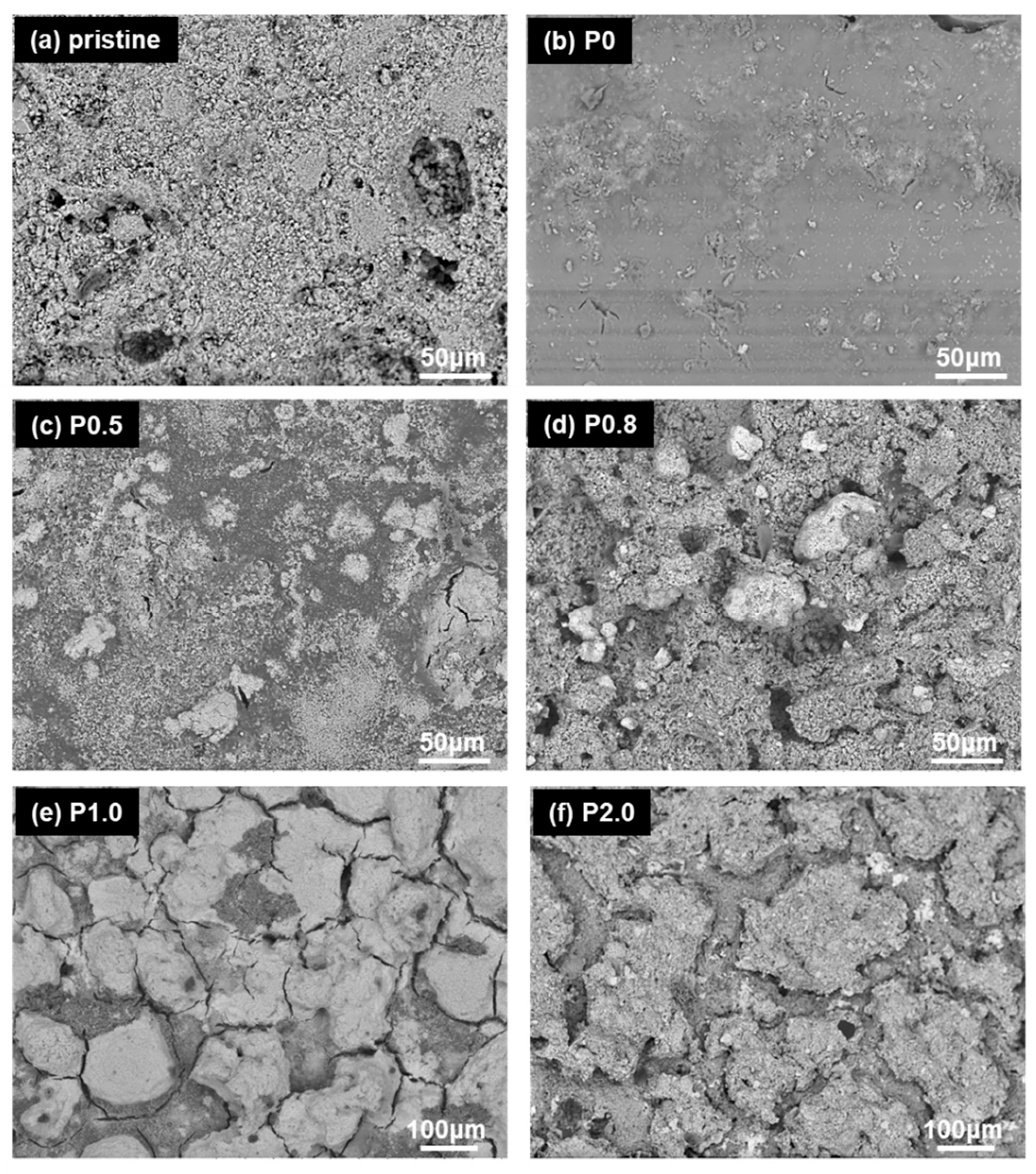
Figure 2.
(a) Contact angle (CA) and contact angle hysteresis (CAH) of water drops on coated limestone samples vs the ZnO NP concentration. (b) Advancing (ACA) and receding (RCA) contact angles of water drops on coated limestone samples vs the ZnO NP concentration.
Figure 2.
(a) Contact angle (CA) and contact angle hysteresis (CAH) of water drops on coated limestone samples vs the ZnO NP concentration. (b) Advancing (ACA) and receding (RCA) contact angles of water drops on coated limestone samples vs the ZnO NP concentration.
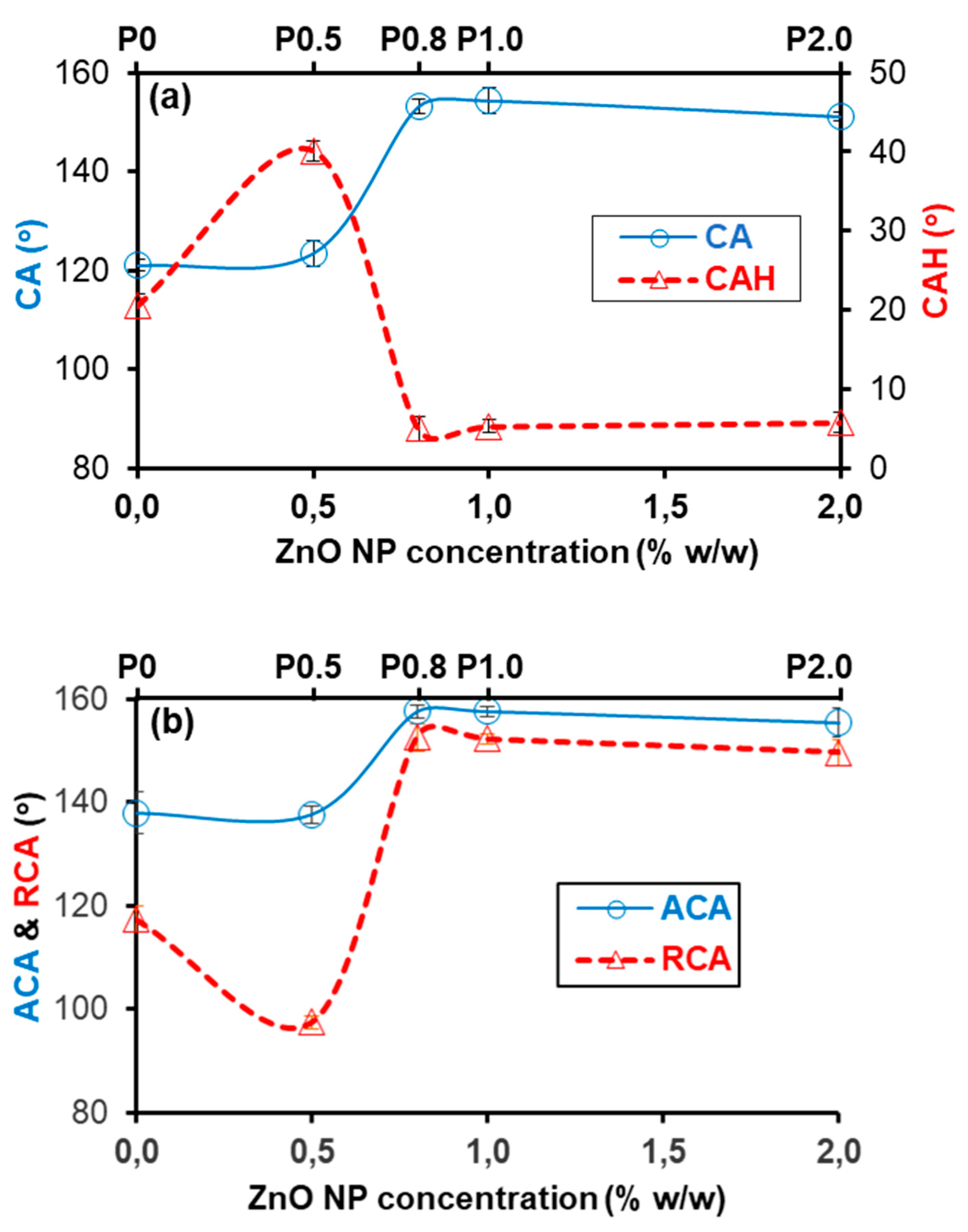
Figure 3.
(a) Successive snapshots showing the physical self-cleaning scenario (lotus effect) on contaminated limestone, treated with the P0.8 coating. (b) Water jet flow repelled by the limestone sample which was treated with the P0.8 coating.
Figure 3.
(a) Successive snapshots showing the physical self-cleaning scenario (lotus effect) on contaminated limestone, treated with the P0.8 coating. (b) Water jet flow repelled by the limestone sample which was treated with the P0.8 coating.
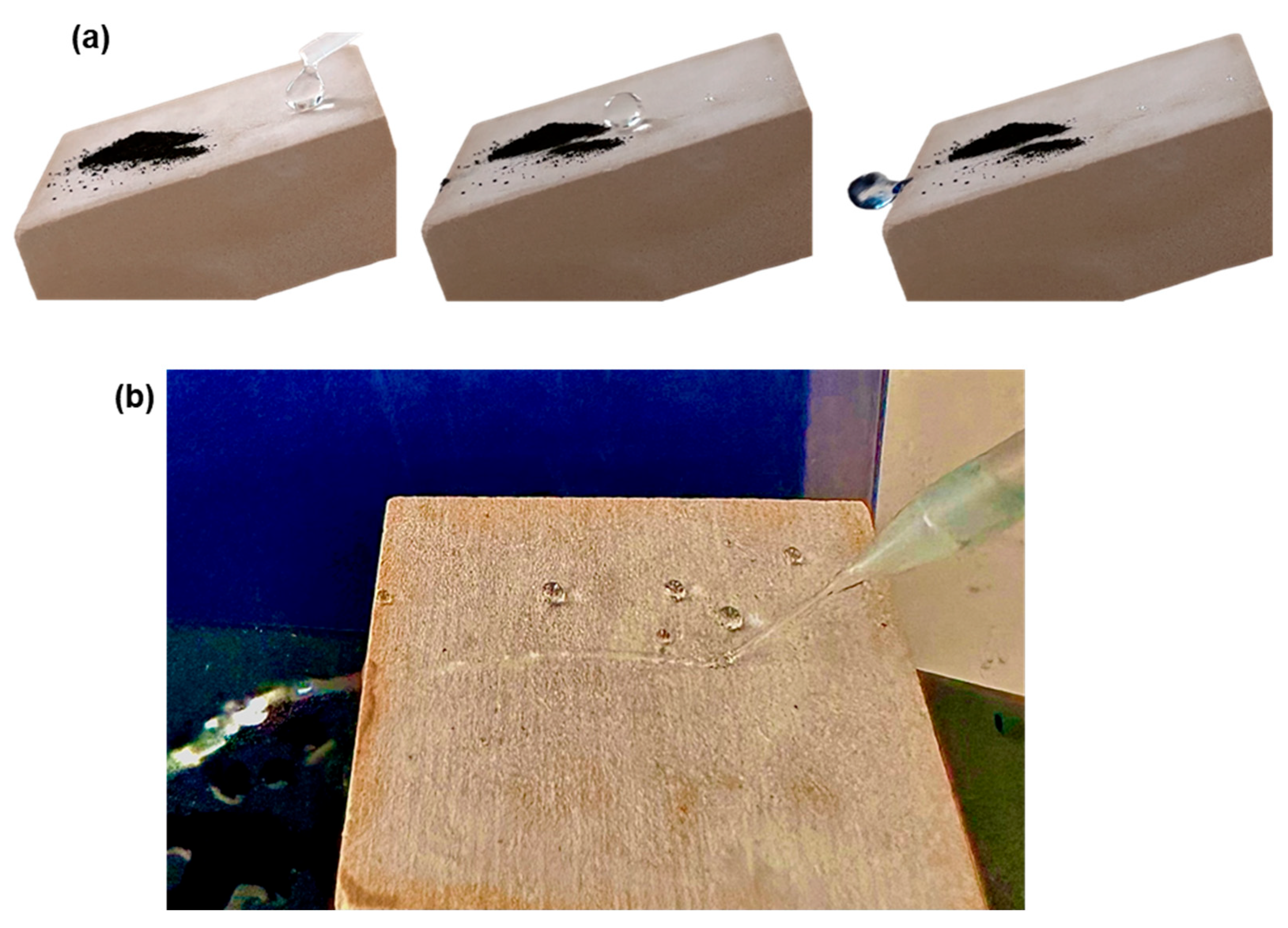
Figure 4.
Colour change () of coated limestone samples vs the ZnO NP concentration. The colours of the limestone samples changed due to the application of the coatings. The mean values of the calculated changes of the , and components are included in the graph.
Figure 4.
Colour change () of coated limestone samples vs the ZnO NP concentration. The colours of the limestone samples changed due to the application of the coatings. The mean values of the calculated changes of the , and components are included in the graph.
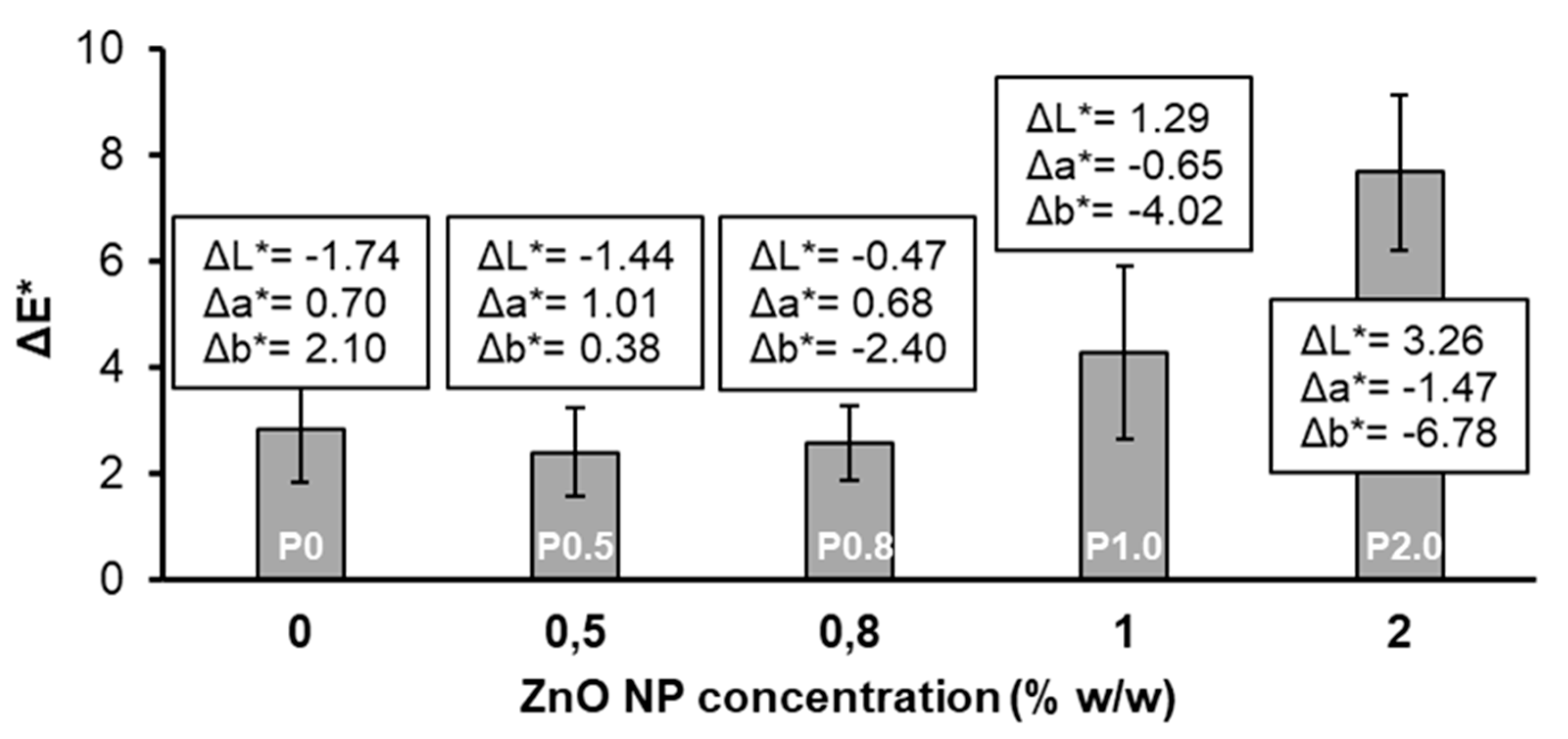
Figure 5.
Results for the tape peeling test which was applied on limestone samples treated with the P0.8 and P2.0 coatings. The CA vs the number of cycles is shown. Twenty-five (25) attachment-detachment cycles were applied in total.
Figure 5.
Results for the tape peeling test which was applied on limestone samples treated with the P0.8 and P2.0 coatings. The CA vs the number of cycles is shown. Twenty-five (25) attachment-detachment cycles were applied in total.
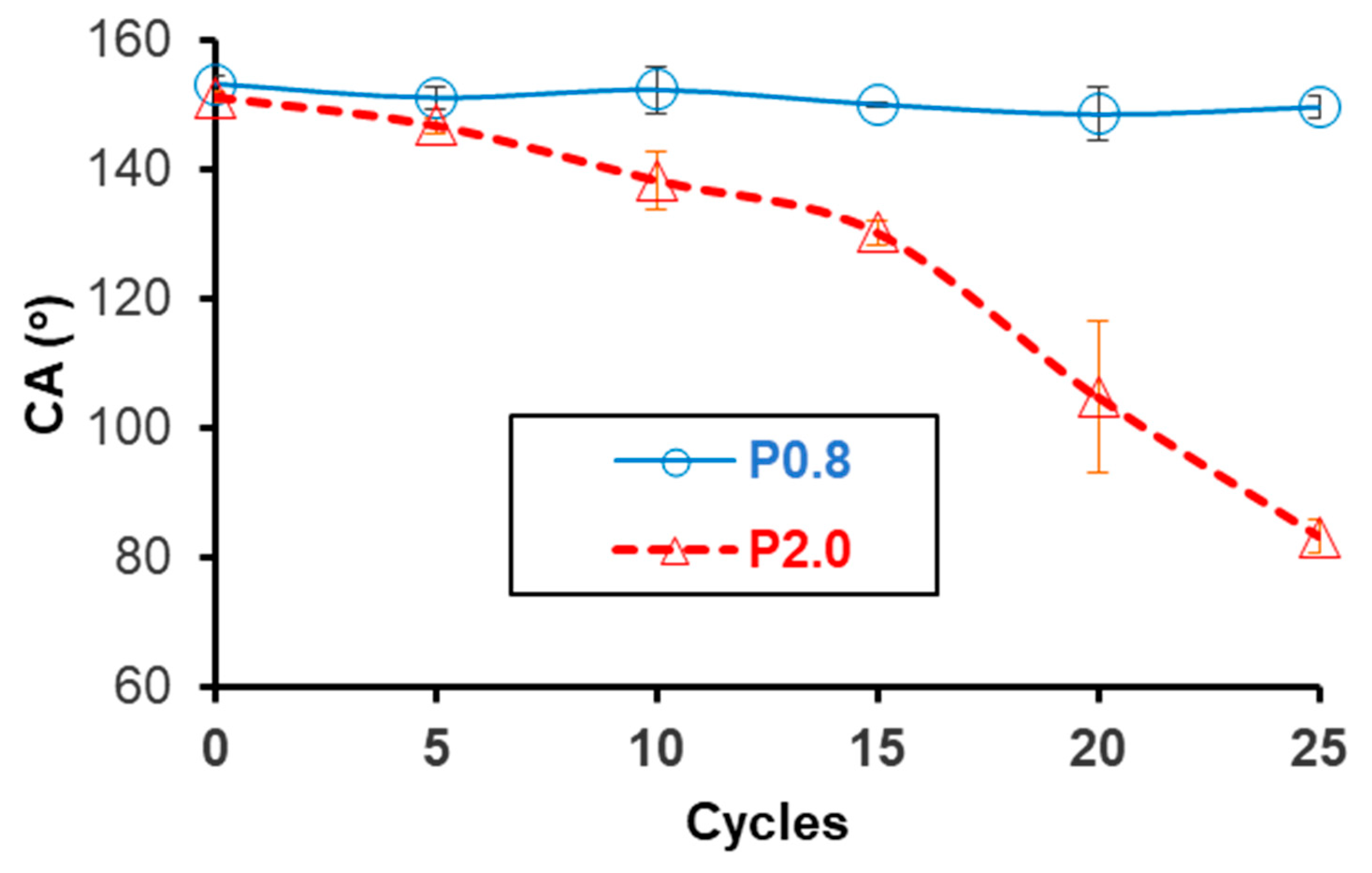
Figure 6.
(a) Contact angle hysteresis (CAH) and (b) colour change () measured before and after the application of 25 attachment-detachment cycles of the tape peeling test on limestone samples which were treated with the P0.8 and P2.0 coatings. The ΔΕ* calculations in (b) were conducted with respect to the pristine, uncoated limestone.
Figure 6.
(a) Contact angle hysteresis (CAH) and (b) colour change () measured before and after the application of 25 attachment-detachment cycles of the tape peeling test on limestone samples which were treated with the P0.8 and P2.0 coatings. The ΔΕ* calculations in (b) were conducted with respect to the pristine, uncoated limestone.
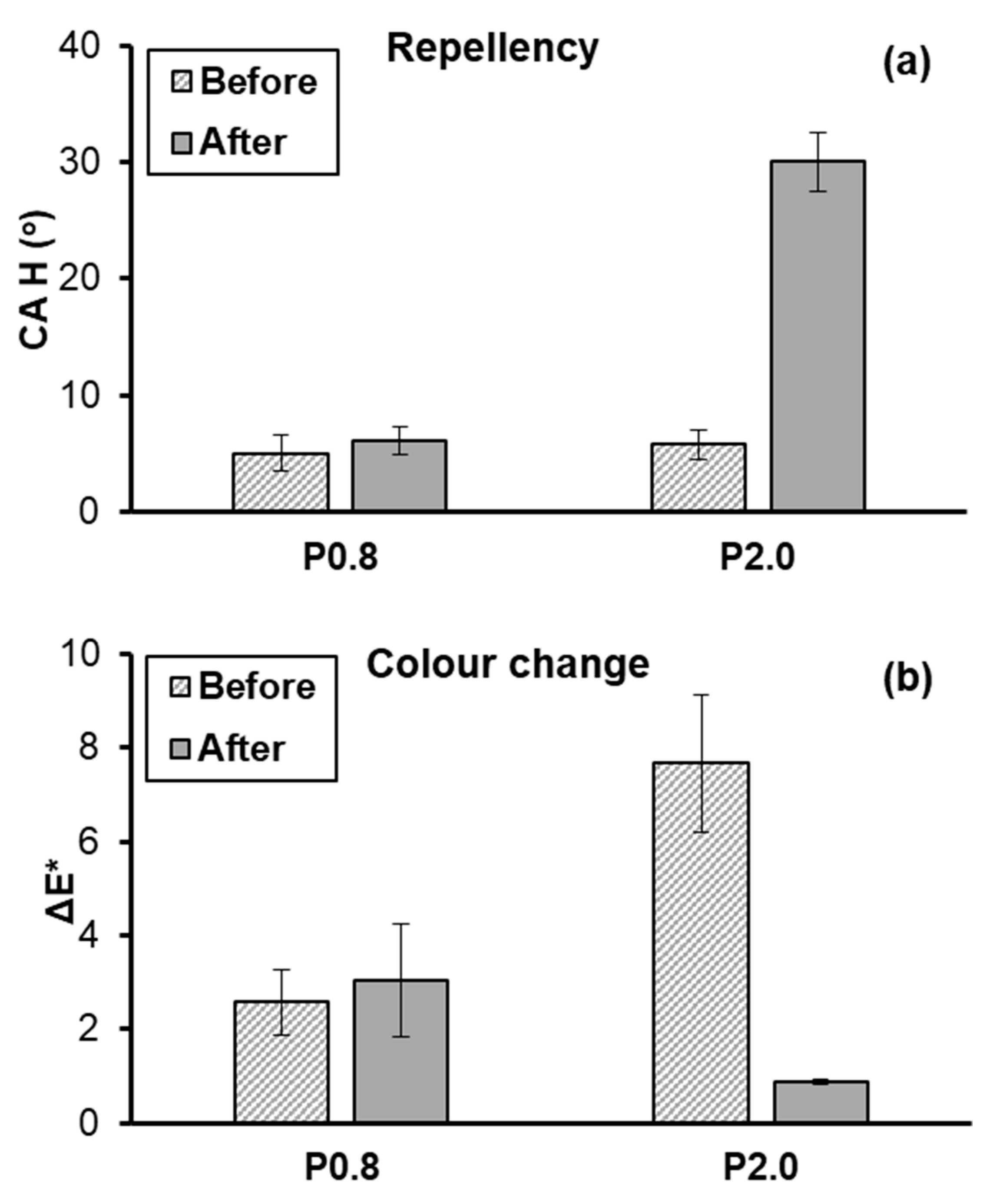
Figure 7.
Cleaning efficacies () of coated (P0 and P0.8) and uncoated limestones, which were contaminated with methylene blue, were calculated using Equation 5 for various periods of treatment under the UV light. .
Figure 7.
Cleaning efficacies () of coated (P0 and P0.8) and uncoated limestones, which were contaminated with methylene blue, were calculated using Equation 5 for various periods of treatment under the UV light. .
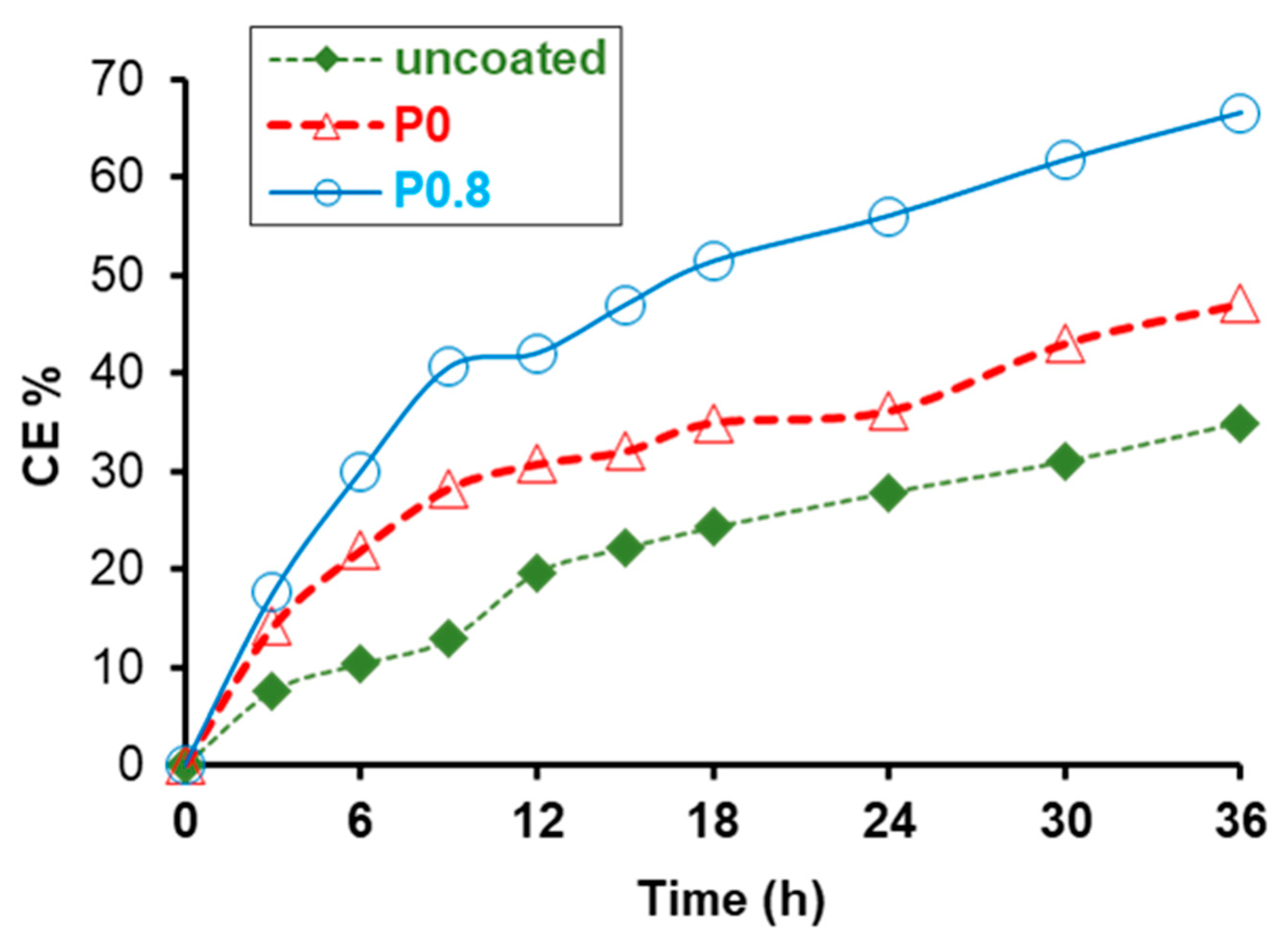
Figure 8.
The graphs show the cfu/mL that was retrieved from limestones coated with P0 and P0.8 and inoculated with (a) E. coli and (b) S. aureus liquid cultures, in comparison to the reference (Ref).
Figure 8.
The graphs show the cfu/mL that was retrieved from limestones coated with P0 and P0.8 and inoculated with (a) E. coli and (b) S. aureus liquid cultures, in comparison to the reference (Ref).

Figure 9.
Stability of the P0.8 coating on limestone. (a) CA and (b) results before and after exposing the samples to artificially accelerated UV radiation. (c) CA of drops of aqueous solutions vs the drop pH.
Figure 9.
Stability of the P0.8 coating on limestone. (a) CA and (b) results before and after exposing the samples to artificially accelerated UV radiation. (c) CA of drops of aqueous solutions vs the drop pH.
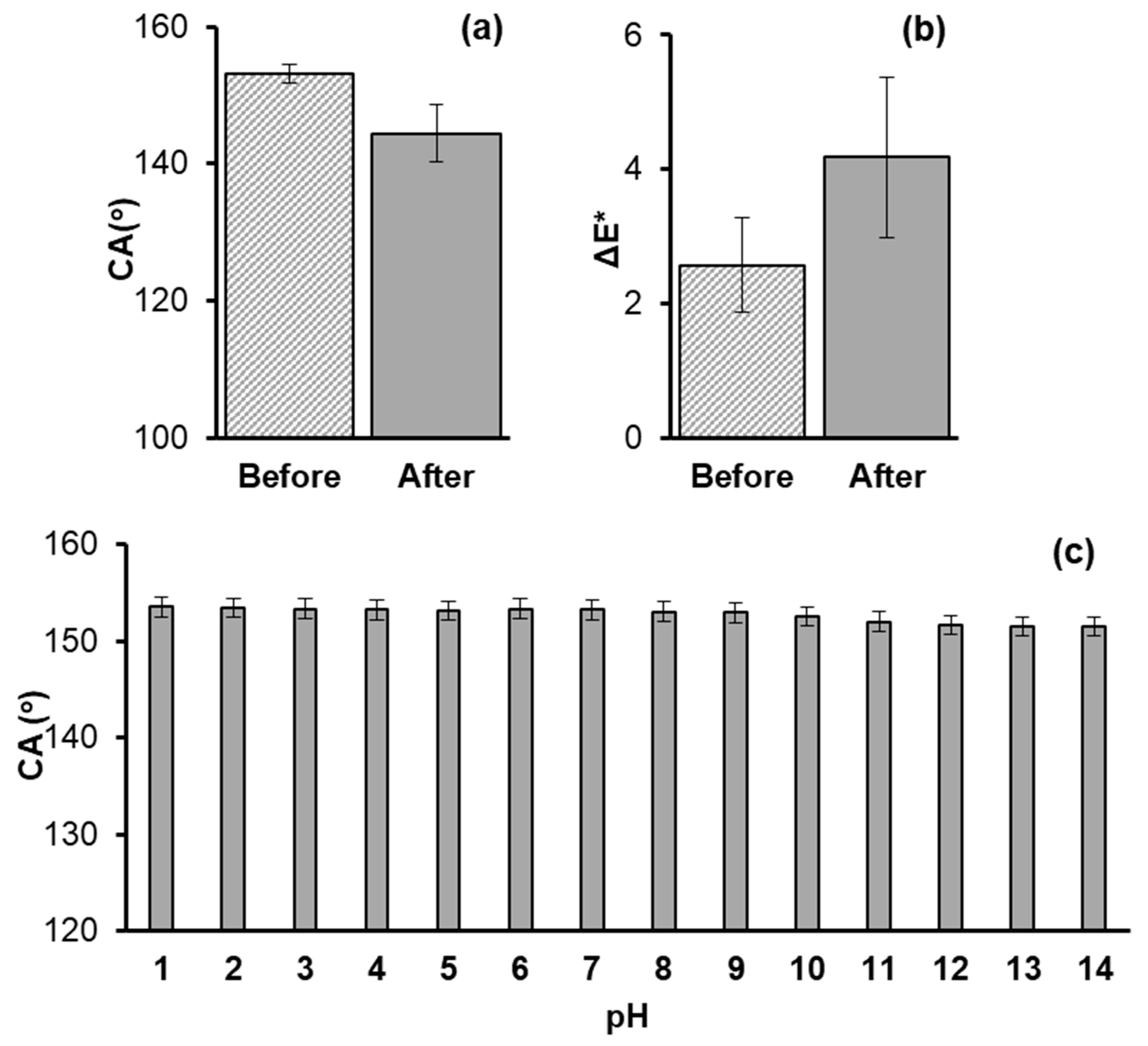
Table 1.
Dispersive () and polar () components of the surface free energy of the liquid () for water and diiodomethane [47]. CAs of water and diiodomethane are included.
Table 1.
Dispersive () and polar () components of the surface free energy of the liquid () for water and diiodomethane [47]. CAs of water and diiodomethane are included.
| Liquid | (mJ m-2) | (mJ m-2) | (mJ m-2) | CA (°) |
|---|---|---|---|---|
| Water | 21.8 | 51.0 | 72.8 | 153.2±1.4 |
| Diiodomethane | 49.5 | 1.3 | 50.8 | 129.5±2.3 |
Disclaimer/Publisher’s Note: The statements, opinions and data contained in all publications are solely those of the individual author(s) and contributor(s) and not of MDPI and/or the editor(s). MDPI and/or the editor(s) disclaim responsibility for any injury to people or property resulting from any ideas, methods, instructions or products referred to in the content. |
© 2024 by the authors. Licensee MDPI, Basel, Switzerland. This article is an open access article distributed under the terms and conditions of the Creative Commons Attribution (CC BY) license (http://creativecommons.org/licenses/by/4.0/).
Copyright: This open access article is published under a Creative Commons CC BY 4.0 license, which permit the free download, distribution, and reuse, provided that the author and preprint are cited in any reuse.
Alerts
MDPI Initiatives
Important Links
© 2025 MDPI (Basel, Switzerland) unless otherwise stated









